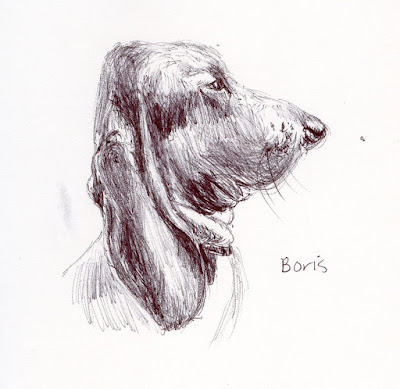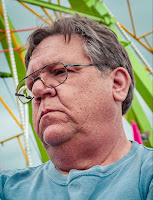 |
| 9/30/22 Contourless hatching at Caffe Vita, Fremont |
We’re a week into InkTober, and I’m more excited about
this annual challenge than I have been in several years! Last year I felt aimless,
so I decided to do blind contours for the month. They were fun, but not
challenging, and I’m not sure I learned anything. The year before that, I was
heavily into drawing my hand daily, and I didn’t want yet another thing to do
every day, so I just made my daily hands with ink for the month. Again,
it was fun to use materials not often used, but not particularly challenging.
In September this year I was looking ahead to InkTober and thought I’d try something new as well as challenging: hatching without initial contour lines. Inspired by an artist I follow on Instagram, kiwon.05, I tried to emulate that style and wanted to give it a solid try. Up to that point, I had practiced only simple, single objects, not scenes. The day before InkTober began, I went to Caffe Vita with Ching to see if I could make a typical urban sketch with that technique (top of post). It was so daunting that I changed my mind! I may still practice it during InkTober, but I didn’t want to commit to a whole month of it.
Fortunately, a few days prior to that, I had just begun France van Stone’s “How I Crosshatch” online course. Immediately, I knew I wanted to commit to practicing her methods, and InkTober was just right for it! Not only is it fun; it is extremely challenging to make portraits in 30 minutes or less. It’s exactly what I want InkTober to be – both fun and challenging, but not too time consuming. Although France’s favorite medium is Bic ballpoint, she demos other materials in the crosshatching course too, such as fountain pen, Sakura Pigma Micron, graphite and even digital (I’m skipping that section). I’m practicing the same media she demos because it’s informative to understand how they differ in terms of crosshatching, but I’m still doing at least one crosshatched drawing a day in ink for the challenge.
On Day 1, I made the Bic portrait below slightly smaller than the previous ones (about 3 inches tall instead of 4 inches) because I thought it would help in terms of the time limit. Unfortunately, that meant that I had difficulty with details like the subject’s eyes. After that, I went back to about 4 inches as my standard size, which is about the size of France’s demo drawings, too.
 |
| 10/1/22 Bic ballpoint, 30 minutes |
 |
| Reference photo by @Earthsworld |
Day 2 was such a treat: The subject was France’s Basset hound, Boris! With such a dignified posture, jowls of wisdom, and the beautiful drape of his ear, Boris was a joy to draw.
 |
| 10/2/22 Bic ballpoint, 30 minutes |
 |
| Photo reference provided by France van Stone |
The next day’s model was more challenging than the previous humans. A much younger man, his dark skin was very smooth and shiny with brilliant highlights, some of which I sadly lost. Part of France’s method is to make fast marks and keep the hand moving, which I don’t have a problem with – until I realize I’ve just scribbled quickly over a highlight I meant to reserve. Oct. 3’s portrait also made me realize that I hadn’t been paying enough attention to varying the density of my marks, which is an important part of crosshatching for modulating tones. With ballpoint, France also emphasizes using light pressure throughout and building value through multiple layers (exactly the way classical colored pencil artists work, incidentally). Under time constraints, I started using too much pressure, and the messy hatching looks even messier.
 |
| 10/3/22 Bic ballpoint, 30 minutes |
 |
| Reference photo courtesy of Ben Davies |
The subject was the first female I have tried with this method, and a young one, to boot. In my decade of life drawing experience, I have always found young women to be the most challenging of models. Give me a craggy old man any day! And for a portrait, all the more! Although I have practiced crosshatching sporadically (especially during InkTober), one reason I have shied away from this technique with human models is that it always seems to look so harsh when depicting form on faces and bodies. I adore using soft pencils or other easily blendable dry materials to show subtle shifts in the gently curving planes of a face. By contrast, I winced the entire time I shaded this teenager’s face with such strident, unforgiving lines – indelibly made with waterproof Platinum Carbon Black ink and my assertive Sailor fude de Mannen fountain pen!
 |
| 10/4/22 Sailor fude fountain pen, Platinum Carbon ink, 30 minutes |
 |
| Reference photo by @Earthsworld |
I got over it the next day, though: The course assignment I used for Day 5’s drawing was a 15-minute portrait. We were to choose a reference photo we had used previously and draw it again, this time using a different medium. I felt I hadn’t done justice to the photo I’d used on Oct. 1 (man wearing the red beanie cap), which is such a great face, so I chose that one, and I sketched with a Uni Pin 0.5mm pen. France’s favorite technical pen is the Sakura Pigma Micron, which I had used years ago when I first started sketching. Since then, I’ve discovered other technical pen brands I prefer, including this Uni Pin. Although this pen is no less harsh than the previous day’s Sailor fude, with only 15 minutes on the clock, I had no time to fuss about offending the subject with the harshness of my marks.
 |
| 10/5/22 Uni Pin 0.5mm pen, 15 minutes |
And you know what? I like this one much better than my first attempt! Not only is it slightly better at capturing a likeness (or maybe more his essence), it also seems fresher. Granted, a 30-minute portrait could hardly be overworked, let alone a 15-minute one, and yet having half the time forced me to be even more economical with my marks. Not a single stroke wasted here. As a second attempt, I also observed more closely. For example, I suddenly saw that the center seam of his cap aligns with his nose, so I took advantage of it to help me place the nose in the center of his face. In my Oct. 1 attempt, I drew the center seam, but didn’t see that it should align with his nose.
When France finishes a 30- or 15-minute demo portrait, she will often exclaim that it brings her so much joy to know that she can capture a face in such a short time. When she was younger, she told us, she enjoyed spending hours upon hours meticulously crosshatching a portrait. After she had a child, however, she could no longer carve out chunks of time for that kind of drawing, but she wanted to continue her drawing practice. That’s how she came to develop her faster methods that have led to “dirty” crosshatching. When I finished the portrait of the man in the beanie, I, too, felt the joy of capturing a face in such a short time.
Day 6 was another 15-minute exercise. France made her demo
drawing with a light gray Pigma Micron, which she encouraged us to try. I didn’t
have a gray one, so I used a gray Copic Multiliner SP 0.3mm pen instead. It’s
another brand of fineliner I used often when I first started sketching. I loved
it so much that I bought it in many colors and tip sizes. Now, however, I can’t
imagine what I liked about it. The tip must be held nearly vertically to get a good
line – the opposite of a fude nib that gives a great, variable line at any
angle. The ink might have been going dry, too, given that I hadn’t used it in a
decade. But in 15 minutes, I didn’t have time to grouse about anything – I just
hatched and scribbled madly to capture as much as I could.
 |
| 10/6/22 Copic Multiliner SP 0.3mm, 15 minutes |
 |
| Reference photo by @Earthsworld |
For Day 7, I borrowed a reference photo from the section on
digital drawing. I liked the softness of the previous day’s gray ink, but not
the pen, so I tried a gray Uni Pin brush pen instead. I’m not going to use a brush pen for
hatching anymore – the result looks way too hairy.
 |
| 10/7/22 Uni Pin brush pen, 15 minutes |
 |
| Reference photo by @Earthsworld |
France always urges us not to focus on resemblance when we make portraits; it’s the process and what we learn from it that’s important. As a process-oriented sketcher, I agree with her completely, and it’s also reassuring to hear. Just the same, it’s hard not to strive for resemblance.
A note on the reference photos: Most of the photos France has used in her demos were taken by the remarkable photographer who goes by the name Earthsworld on Instagram. At state fairs, music festivals and other large outdoor events, the Oregon photographer takes beautifully lighted, candid portraits. Their expressions are irresistible and so much fun to draw. He generously allows followers to freely use his images as references for art. I have already downloaded favorites to draw during the rest of InkTober.
I think this is such a great Inktober challenge. I love the hatching and am impressed with how well these are coming out!
ReplyDeleteThanks! We'll see if I can keep it up for the month! So far, I'm really enjoying the challenge, as I've never before focused on portraits for any length of time.
Delete